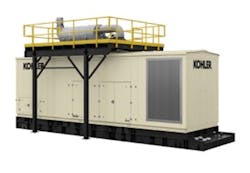Executive Insights: Sean Farney of Kohler Power Systems
The Data Center Frontier Executive Roundtable features insights from industry executives with lengthy experience in the data center industry. Here’s a look at the insights from Sean Farney of Kohler Power Systems.
SEAN FARNEY, Kohler Power Systems
Sean Farney is Director, Marketing & Business Development – Data Center at Kohler Power Systems. He leads segment growth supporting Kohler’s data center power systems strategy, including channel programs, brand awareness, product performance, and solutions differentiation, and partnering with the sales team to prioritize, develop, and execute a global customer acquisition strategy. He was previously a data center executive for Microsoft, and has held leadership positions at The Boston Consulting Group, Intercontinental Exchange, Rockwell Automation and Ubiquity Critical Environments.
Here’s the full text of Sean Farney’s insights from our Executive Roundtable:
Data Center Frontier: In recent months we’ve seen disasters prompt rolling power outages in two of the largest data center markets, California and Texas. Are current approaches to data center infrastructure and operations sufficient? Or are there new strategies to consider in the face of energy security challenges? What are the new strategies?
Sean Farney: Grid downtime in Texas was simply a failure of imagination. Here in Wisconsin, we’ve got a foot of snow on the ground and are just coming off of two weeks of subzero temperatures. We’ve had no interruption in utility feed because extreme winter weather was part of the Basis of Design during the engineering phase. The folks designing the Texas grid just didn’t ask “what if” vis-a-vis the realm of weather possibilities – they didn’t imagine severe winter weather and protections against it weren’t built in.
Fortunately, we data center operators are a paranoid bunch and ask “what if” ad nauseum. We are also contractually bound to remunerate customers for uptime SLA violations and our annual bonus reflects it. This is why I stored 250,000 gallons of diesel fuel underground while running a facility for Microsoft; the lights had to stay on.
And this is why despite an unimaginative grid design, you haven’t heard about data centers going dark in Texas. We should actually be celebrating the prescient professionals who already had a plan for grid down and rolled right over to generator power. Unfortunately, the state will have a Texas-sized Site Selection blackeye due to power reliability concerns for several years.
EPA Certified Tier 4 Final generator (Image: Courtesy of Kohler)
Data Center Frontier: Our industry is all about the data. But how good are our metrics? What are the strengths and opportunities in how the data center industry can measure and manage effectiveness? What’s going well and what’s missing?
Sean Farney: Well Kermit was right, “it’s not easy being green.” And because we don’t have a unified way to measure multi-variate sustainability across the entire data center consumption ecosystem- power, water, and emissions – it’s not easy to manage, measure, and continuously improve on industry sustainability standards. This is an opportunity for us to be proactive before these pressures become acute. We have a great story to tell and need a metric, like Christian Belady’s PUE, to frame it. A more in-depth discussion can be found here: PUE to GUE: Metrics Must Keep Pace With Data Center Sustainability (datacenterfrontier.com)
Data Center Frontier: Data center tours and conferences are two key elements of doing business in this sector. What’s your sense of when these in-person activities can resume, and how they might be different?
Sean Farney: I suspect that by late summer/early fall the combination of widespread vaccination and complete lockdown fatigue will usher in a re-opening of face-to-face industry events.
The data center industry, similar to the trades, is knit together by close working relationships. COVID’s travel restrictions have us starving for connection that a year’s worth of virtual events just hasn’t been able to fulfill. Even pre-quarantine, many of us were attending conferences more for the networking opportunities than the oft recycled content.
Post-pandemic, the industry has an opportunity to shift the desired outcome of filling seats & receiving clicks; an Event, to creating connection and making impact; an Experience. To do this, you bring intimate affinity groups together in a gracious environment, engage in thought leadership exercises, and sprinkle in a little fun.
Data Center Frontier: What are the top challenges in securing data center environments, and how do we address them in edge computing scenarios?
Sean Farney: Physical security in the service provider data centers – which is usually driven by the standardized controls that govern audit compliance – is rarely cause for concern. It’s the logical security – OSI Layers 2, 3 and 4- which are today’s greatest IT security challenges.
The risk in the Edge segment is that there are many smaller players with a handful of sites who may be more susceptible to compromise because they lack the scale and maturity of their MTDC and Hyperscale brethren. Once the Edge market matures and is consolidated and absorbed by a global MTDC or two, this risk diminishes.
